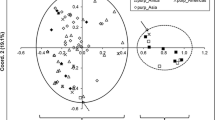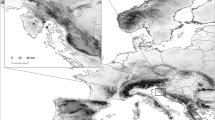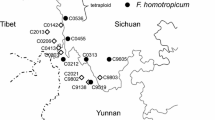Abstract
Key message
All East African Highland Banana varieties are genetically uniform having arisen from a single clone introduced to Africa.
Abstract
East African Highland bananas (EAHBs) are a subgroup of triploid (AAA genome) bananas of importance to food security in the Great Lakes region of Africa. Little is known about their genetic variation, population structure and evolutionary history. Ninety phenotypically diverse EAHB cultivars were genotyped at 100 SSR microsatellite markers to investigate population genetic diversity, the correlation of genetic variability with morphological classes, and evolutionary origins since introduction to Africa. Population-level statistics were compared to those for plantain (AAB) and dessert (AAA) cultivars representing other M. acuminata subgroups. EAHBs displayed minimal genetic variation and are largely genetically uniform, irrespective of whether they were derived from the distinct Ugandan or Kenyan germplasm collections. No association was observed between EAHB genetic diversity and currently employed morphological taxonomic systems for EAHB germplasm. Population size dynamics indicated that triploid EAHBs arose as a single hybridization event, which generated a genetic bottleneck during foundation of the EAHB genepool. As EAHB triploids are sterile, subsequent asexual vegetative propagation of EAHBs allowed a recent rapid expansion in population size. This provided a basis for emergence of genetically near-isogenic somatic mutants selected across farmers and environments in East Africa over the past 2000 years since EAHBs were first introduced to the African continent.



Similar content being viewed by others
References
Abdullah NAP, Bin Saleh G, Putra ETS, Bin Wahab Z (2012) Genetic relationship among Musa genotypes revealed by microsatellite markers. Afr J Biotechnol 11(26):6769–6776
Amos W, Hoffman JIW (2010) Evidence that two main bottleneck events shaped modern human genetic diversity. Proc Biol Sci 277(1678):131–137
Botstein D, White RL, Skolnick M, Davis RW (1980) Construction of a genetic linkage map in man using restriction fragment length polymorphisms. Am J Hum Genet 32(3):314–331
Bryant D, Moulton V (2004) Neighbor-net: an agglomerative method for the construction of phylogenetic networks. Mol Biol Evol 21(2):255–265
Butler D (2013) Fungus threatens top banana: fears rise for Latin American industry as devastating disease hits leading variety in Africa and Middle East. Nature 504:195–196
Butlin R (2002) The costs and benefits of sex: new insights from old asexual lineages. Nat Rev Genet 3:311–317
Buwa R (2009) Using SSR markers to fingerprint the East African Highland banana cultivars. M.Sc., Makerere University
Changadeya W, Kaunda E, Ambali AJD (2012) Molecular characterization of Musa cultivars in Malawi using SSR. Afr J Biotechnol 11(18):4140–4157
Christelova P, Valarik M, Hribova E, Van den Houwe I, Channeliere S, Roux N, Dolezel J (2011) A platform for efficient genotyping in Musa using microsatellite markers. AoB Plants 2011:plr024
Cooper H, Spillane C, Hodgkin T (2000) Broadening the genetic bases of crop production. IPGRI, FAO, CABI, Rome (Italy), Wallingford (UK)
Cornuet JM, Luikart G (1996) Description and power analysis of two tests for detecting population bottlenecks from allele frequency data. Genetics 144:2001–2014
Crane MB, Lawrence WJC (1956) The genetics of garden plants, 4th edn. Macmillan, London
Creste S, Neto AT, de Oliveira Silva S, Figueira A (2003) Genetic characterization of banana cultivars (Musa spp.) from Brazil using microsatellite markers. Euphytica 132:259–268
Crouch JH, Vuylsteke D, Ortiz R (1997) Microsatellite markers for molecular breeding of Musa. InfoMusa 6(1):5–6
de Jesus ON, Silva Sde O, Amorim EP, Ferreira CF, de Campos JM, Silva Gde G, Figueira A (2013) Genetic diversity and population structure of Musa accessions in ex situ conservation. BMC Plant Biol 13:41
De Langhe E (1961) La taxonomie du bananier plantain en Afrique Équatoriale. Journal d'agriculture tropicale et de botanique appliquée 8:417–449
De Langhe EA (1964) The origin of variation in the plantain banana. Mededelingen van de Landbouwhogeschool en de Opzoekingsstations van de Staat te Gent 39:45–80
DeGiorgio M, Degnan JH, Rosenberg NA (2011) Coalescence-time distributions in a serial founder model of human evolutionary history. Genetics 189(2):579–593
Dellaporta S, Wood J, Hicks J (1983) A plant DNA minipreparation: version II. Plant Mol Biol Rep 1:19–21
D’Hont A, Denoeud F, Aury JM, Baurens FC, Carreel F, Garsmeur O, Noel B, Bocs S, Droc G, Rouard M et al (2012) The banana (Musa acuminata) genome and the evolution of monocotyledonous plants. Nature 488(7410):213–217
Di Rienzo A, Peterson AC, Garza JC, Valdes AM, Slatkin M, Freimer NB (1994) Mutational processes of simple-sequence repeat loci in human populations. Proc Natl Acad Sci 91(8):3166–3170
Drummond AJ (2005) Bayesian coalescent inference of past population dynamics from molecular sequences. Mol Biol Evol 22(5):1185–1192
Drummond AJ, Rambaut A (2007) BEAST: Bayesian evolutionary analysis by sampling trees. BMC Evol Biol 7:214
Earl DA (2011) STRUCTURE HARVESTER: a website and program for visualizing STRUCTURE output and implementing the Evanno method. Conserv Genet Resour 4(2):359–361
El-Khishin D, Belatus EL, El-Hamid AA, Radwan KH (2009) Molecular characterization of banana cultivars (Musa spp.) from Egypt using AFLP. Res J Agric Biol Sci 5(3):272–279
Evanno G, Regnaut S, Goudet J (2005) Detecting the number of clusters of individuals using the software STRUCTURE: a simulation study. Mol Ecol 14(8):2611–2620
Falush D, Stephens S, Pritchard JK (2007) Inference of population structure using multilocus genotype data: dominant markers and null alleles. Mol Ecol Notes 7:574–578
Fu Y-X, Chakraborty R (1998) Simultaneous estimation of all the parameters of a stepwise mutation model. Genetics 150:487–497
Galov A, Byrne K, Gomerčić T, Duras M, Arbanasić H, Sindičić M, Mihelić D, Kovačić A, Funk SM (2013) Genetic structure and admixture between the Posavina and Croatian coldblood in contrast to the Lippizan horse from Croatia. Czech J Anim Sci 58(2):71–78
Ganapathy KN, Gomashe SS, Rakshit S, Prabhakar B, Ambekar SS, Ghorade RB, Biradar BD, Saxena U, Patil JV (2012) Genetic diversity revealed utility of SSR markers in classifying parental lines and elite genotypes of sorghum (Sorghum bicolor L. Moench.). Aust J Crop Sci 6(11):1486–1493
García-Bastidas F, Ordóñez N, Konkol J, Al-Qasim M, Naser Z, Abdelwali M, Salem N, Ploetz RC, Kema GHJ (2014) First report of Fusarium oxysporum f. sp. cubense tropical race 4 associated with Panama disease of banana outside Southeast Asia. Plant Disease 98:694
Gebremedhin B, Ficetola GF, Naderi S, Rezaei HR, Maudet C, Rioux D, Luikart G, Flagstad Ø, Thuiller W, Taberlet P (2009) Combining genetic and ecological data to assess the conservation status of the endangered Ethiopian walia ibex. Anim Conserv 12(2):89–100
Goldstein DB, Ruiz Linares A, Cavalli-Sforza LL, Feldman MW (1995) An evaluation of genetic distances for use with microsatellite loci. Genetics 139(1):463–471
Heled J, Drummond AJ (2008) Bayesian inference of population size history from multiple loci. BMC Evol Biol 8:289
Heslop-Harrison JS, Schwarzacher T (2007) Domestication, genomics and the future for banana. Ann Bot 100(5):1073–1084
Hippolyte I, Bakry F, Seguin M, Gardes L, Rivallan R, Risterucci AM, Jenny C, Perrier X, Carreel F, Argout X et al (2010) A saturated SSR/DArT linkage map of Musa acuminata addressing genome rearrangements among bananas. BMC Plant Biol 10:65
Hippolyte I, Jenny C, Gardes L, Bakry F, Rivallan R, Pomies V, Cubry P, Tomekpe K, Risterucci AM, Roux N et al (2012) Foundation characteristics of edible Musa triploids revealed from allelic distribution of SSR markers. Ann Bot 109(5):937–951
Hoban S, Gaggiotti OE, Bertorelle G (2013) The number of markers and samples needed for detecting bottlenecks under realistic scenarios, with and without recovery: a simulation -based study. Mol Ecol 22:3444–3450
Huson DH, Bryant D (2006) Application of phylogenetic networks in evolutionary studies. Mol Biol Evol 23(2):254–267
Karamura D (1998) Numerical taxonomic studies of the East African highland bananas (Musa AAA- East Africa) in Uganda. Doctor of Philosophy, PGRI, Reading
Kennedy J (2008) Pacific Bananas: complex origins, multiple dispersals? Asian Perspect 47:75–94
Lewontin R (1972) The apportionment of human diversity. Evol Biol 6:381–398
Li L, Wang HY, Zhang C, Wang XF, Shi FX, Chen WN, Ge XJ (2013) Origins and domestication of cultivated banana inferred from chloroplast and nuclear genes. PLoS One 8(11):e80502
Liu K, Muse SV (2005) PowerMarker: an integrated analysis environment for genetic marker analysis. Bioinform Appl Note 21(9):2128–2129
Luikart G, Allendorf FW, Cornuet JM, Sherwin WB (1998) Distortion of allele frequency distributions provides a test for recent population bottlenecks. Am Genet Assoc 89(3):238–247
Mace E, Buhariwalla K, Buhariwalla H, Crouch J (2003) A high-throughput DNA extraction protocol for tropical molecular breeding programs. Plant Mol Biol Rep 21:459–460
Mariette S, Tavaud M, Arunyawat U, Capdeville G, Millan M, Salin F (2010) Population structure and genetic bottleneck in sweet cherry estimated with SSRs and the gametophytic self-incompatibility locus. BMC Genet 11:77
Martin G, Baurens FC, Cardi C, Aury JM, D’Hont A (2013) The complete chloroplast genome of banana (Musa acuminata, Zingiberales): insight into plastid monocotyledon evolution. PLoS One 8(6):e67350
Maruyama T, Fuerst PA (1985) Population bottlenecks and nonequilibrium models in population genetics. II. Number of alleles in a small population that was formed by a recent bottleneck. Genetics 111(3):675–689
Mbanjo EGN, Tchoumbougnang F, Mouelle AS, Oben JE, Nyine M, Dochez C, Ferguson ME, Lorenzen J (2012) Development of expressed sequence tags-simple sequence repeats (EST-SSRs) for Musa and their applicability in authentication of a Musa breeding population. Afr J Biotechnol 11(71):13546–13559
McEachern MB, Van Vuren DH, Floyd CH, May B, Eadie JM (2011) Bottleneck and rescue effects in fluctuating population of golden mantle ground squirrels. Conserv Genet 12:285–296
Miller M, Haig SM, Mullins Thomas D, Poppe KJ, Green M (2012) Evidence for population bottlenecks and subtle genetic structure in the Yellow Rail. The Condor 114(1):100–112
Nei M (1973) Analysis of gene diversity in subdivided populations. Proc Natl Acad Sci USA 70:3321–3323
Opara UL, Jacobson D, Al-Saady NA (2010) Analysis of genetic diversity in banana cultivars (Musa cvs.) from the South of Oman using AFLP markers and classification by phylogenetic, hierarchical clustering and principal component analyses. J Zhejiang Univ Sci B 11(5):332–341
Ortiz R, Swennen R (2014) From crossbreeding to biotechnology-facilitated improvement of banana and plantain. Biotechnol Adv 32(1):158–169
Pachuau L, Atom AD, Thangjam R (2014) Genome classification of Musa cultivars from northeast India as revealed by ITS and IRAP markers. Appl Biochem Biotechnol 172(8):3939–3948
Peakall R, Smouse PE (2012) GenAlEx 6.5: genetic analysis in Excel. Population genetic software for teaching and research—an update. Bioinformatics 28(19):2537–2539
Perrier X, Bakry F, Carreel F, Jenny C, Horry JP, Lebot V, Hippolyte I (2009) Combining biological approaches to shed light on evolution of edible bananas. Ethnobot Res Appl 7:199–216
Perrier X, De Langhe E, Donohue M, Lentfer C, Vrydaghs L, Bakry F, Carreel F, Hippolyte I, Horry JP, Jenny C et al (2011) Multidisciplinary perspectives on banana (Musa spp.) domestication. Proc Natl Acad Sci 108(28):11311–11318
Pillay M, Ogundiwin E, Nwakanma D, Ude G, Tenkouano A (2001) Analysis of genetic diversity and relationships in East African banana germplasm. Theor Appl Genet 102(6–7):965–970
Piry S, Luikart G, Cornuet J-M (1999) Bottleneck: a computer program for detecting recent reductions in the effective population size using allele frequency data. J Hered 90(4):502–503
Pritchard JK, Stephens M, Donnelly P (2000) Inference of population structure using multilocus genotype data. Genetics 155(2):945–959
Resmi L, Kumari R, Bhat KV, Nair AS (2011) Molecular Characterization of genetic diversity and structure in South Indian Musa cultivars. Int J Bot 7(4):274–282
Sainudiin R, Durrett RT, Aquadro CF, Nielsen R (2004) Microsatellite mutation models: insights from a comparison of humans and chimpanzees. Genetics 168:383–395
Scarcelli N, Marie Couderc M, Baco MN, Egah J, Vigouroux Y (2013) Clonal diversity and estimation of relative clone age: application to agrobiodiversity of yam (Dioscorea rotundata). BMC Plant Biol 13:178
Schoebel CN, Stewart J, Gruenwald NJ, Rigling D, Prospero S (2014) Population history and pathways of spread of the plant pathogen Phytophthora plurivora. PLoS One 9(1):e85368
Shaibu AA (2012) Genetic diversity analysis of Musa species using amplified fragment length polymorphism and multivariate statistical technique. Int J Biochem Biotechnol 1(6):175–178
Shepherd K (1957) Banana cultivars in East Africa. Trop Agric 34:277–286
Simmonds NW, Shepherd K (1955) The taxonomy and origins of the cultivated bananas. J Linn Soc Lond Bot 55(359):302–312
Slatkin M (1985) Gene flow in natural populations. Annu Rev Ecol Syst 16:393–430
Spencer CC, Neigel JE, Leberg PL (2000) Experimental evaluation of the usefulness of microsatellite DNA for detecting demographic bottlenecks. Mol Ecol 9(10):1517–1528
Ssebuliba RN, Rubaihayo R, Tenkouano A, Makumbi D, Talegera D, Magambo M (2005) Genetic diversity among East African Highland bananas for female fertility. Afr Crop Sci J 13(1):13–26
Till BJ, Jankowicz-Cieslak J, Sagi L, Huynh OA, Utsushi H, Swennen R, Terauchi R, Mba C (2010) Discovery of nucleotide polymorphisms in the Musa gene pool by Ecotilling. Theor Appl Genet 121(7):1381–1389
Tugume AK, Lubega GW, Rubaihayo PR (2003) Genetic diversity of East African Highland bananas using AFLP. Infomusa 11(2):28–32
Ude G, Pillay M, Ogundiwin E, Tenkouano A (2003) Genetic diversity in an African plantain core collection using AFLP and RAPD markers. Theor Appl Genet 107(2):248–255
Vos P, Hogers R, Bleeker M, Reijans M, van de Lee T, Hornes M, Frijters A, Pot J, Peleman J, Kuiper M et al (1995) AFLP: a new technique for DNA fingerprinting. Nucleic Acids Res 23(21):4407–4414
Whitlock R, Hipperson H, Mannarelli M, Butlin RK, Burke T (2008) An objective, rapid and reproducible method for scoring AFLP peak-height data that minimizes genotyping error. Mol Ecol Resour 8(4):725–735
Wu CH, Drummond AJ (2011) Joint inference of microsatellite mutation models, population history and genealogies using transdimensional Markov Chain Monte Carlo. Genetics 188(1):151–164
Acknowledgments
This research was conducted at Biosciences Eastern and Central Africa (BecA)-ILRI and in the Genetics and Biotechnology Lab at the Plant and AgriBiosciences Research Centre (PABC), School of Natural Sciences, National University of Ireland Galway. We thank Dr Kassa Semagn for his invaluable help in data analysis. This research was supported by funding from Irish Aid and the International Institute for Tropical Agriculture (IITA).
Author information
Authors and Affiliations
Corresponding author
Ethics declarations
Conflict of interest
The authors declare that they have no conflict of interest.
Additional information
Communicated by A. H. Schulman.
M. Onyango: Deceased (RIP).
Electronic supplementary material
Below is the link to the electronic supplementary material.
Rights and permissions
About this article
Cite this article
Kitavi, M., Downing, T., Lorenzen, J. et al. The triploid East African Highland Banana (EAHB) genepool is genetically uniform arising from a single ancestral clone that underwent population expansion by vegetative propagation. Theor Appl Genet 129, 547–561 (2016). https://doi.org/10.1007/s00122-015-2647-1
Received:
Accepted:
Published:
Issue Date:
DOI: https://doi.org/10.1007/s00122-015-2647-1




